5th Anniversary Seminer of JANNET

|
(Slide 34) |
|

|
(Slide 35-36) So the village team has experimented with making plastic braces out of old plastic buckets. They made a plaster cast of the leg then made a solid cast from the negative cast. They filled the hollow cast with plaster to make a solid cast. Then they cut a piece of plastic out of the bucket. They put the plastic in an oven, heated it until it becomes very soft. Then they put hot plastic over the cast of the foot and bound it there with a car tire inner tube. |
|

|
||

|
(Slide 37) On the right you see the completed plastic brace. |
|

|
(Slide 38) Here you see a child with his plastic leg splints. |
|

|
(Slide 39) Here you see Marcelo, on of the village technicians, who himself had polio and used braces, making braces for another child. I will tell you this afternoon, if we have time, my own story. But in brief, Marcelo, this person made the plastic braces that I use. The results have been much better than the braces made by the experts in the USA. Here Marcelo is not using plastic buckets to make the braces, but a better stronger plastic called polypropylene, which is available in the city. |
|

|
(Slide 40) Here is Mari, one of the leaders of PROJIMO, who is paraplegic from a spinal cord injury and has become a very strong, very caring person. Here she is modifying the plastic mould for making the brace. Here is Roberto, one of the leaders of the program, together with the mother of a disabled child. The mother is helping make the braces for her child. This helps to demystify the process and involves the family. |
|

|
(Slide 41) Ironically, the most expensive part of making these plastic braces is the plaster bandage for casting the leg because it is a medical supply. Here one of the school boys and one of the disabled workers are rolling their own plaster bandage out of plaster of Paris. They use ordinary building plaster, which is very cheap, with strips of cloth. These homemade plaster bandages cost one-tenth of the commercial plaster bandages. Also in the program, everybody who comes in is asked to help in whatever way they can - from the child to the mother to everyone. |
|

|
(Slide 42) Here the mother of the child is sewing the stocking net to go under the plaster cast of her child. |
|

|
(Slide 43) Here Teresa, a girl with juvenile arthritis, whose legs became very very weak because it hurt to move them. This little boy, who has cerebral palsy, has become Teresa's therapist. He is rolling the ball to her and she kicks it back to him. That kicking begins to move the joints and strengthen the leg muscle so that later maybe she can begin to walk again. This process of disabled people helping each other is a very empowering experience for this boy. |
|

|
(Slide 44) Here again is the idea of disabled people helping one another. This boy was born with spina bifida. He began to walk with difficulty but he got precious sores on a foot, which led to bone infection and loss of his leg. His leg had to be amputated. Then he became almost completely blind from meningitis. Here a visitor from the USA who has cerebral palsy is teaching Jesus karate. Because Jesus, inspite of his multiple disabilities, is still a boy like any other boy, and likes to have the same adventure in sports and so on. |
|

|
(Slide 45) Here Jesus in turn is helping Alicia. Alicia had brain damage from measles when she was a child. Her body is very spastic. She cannot go to the toilet without having someone move her. She does not drink much water so she doesn't like to go to the toilet often, to avoid asking people to help. Because she doesn't drink enough water in the hot weather, she develops dangerous urinary tract infections. So Jesus is taking the responsibility of making sure that Alicia drinks lots of water. This can be life-saving. |
|

|
(Slide 46) Here you see Alicia now helping somebody else. Ramona, the old woman here was blind from cataract, is homeless and was wandering in the streets begging for food. The program took Ramona in. But she was very lonely and unhappy. So Alicia, who can't do much physically, became a friend and companion to Ramona. It made a big difference to Ramona. Fortunately, Ramona is now able to see again because one of our village health workers eventually became a doctor and an eye surgeon. He is now back doing eye surgery in the villages and was able to operate the cataracts of Ramona. Ramona is so happy now that she can see again, that she spends all day cleaning up and doing the maintenance of PROJIMO. |
|
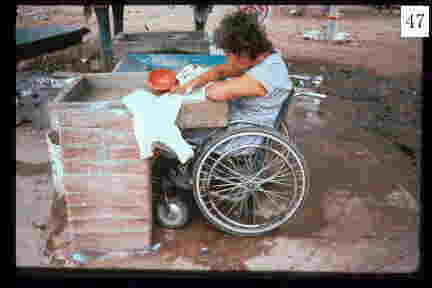
|
(Slide 47) Here is Alicia who has learned to wash her own clothes on a specially designed washing area that is wheelchair accessible. Here is a boy with muscular dystrophy whose weakness has progressed to where he could not lift his hand to feed himself. The village workers cut a half circle out of Styrofoam plastic. In this way, he can rock his arm back and forth with almost no strength and feed himself again. He has become independent again in feeding himself. This is one of many examples of simple solutions that make a big difference to people's lives. |
|
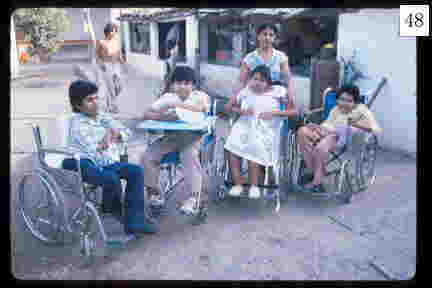
|
(Slide 48) Here is a family that had four children with muscular dystrophy. We would be tempted to say "How tragic." The family went to doctors and the schools, and all replied, "No, we can't do anything for your children. They'll just get weaker and weaker and die." But the family wouldn't accept this and said, "Maybe they will die early but they are alive now and they should have a chance to live as fully as possible."" So with the help of a social worker, the family started a program run by families of disabled children whose needs were not met. They started a school because at that time it was very hard to get a disabled child into a school. In their own school, some of the disabled children were able to teach others. The leaders of the schooling program and the whole program became these children with muscular dystrophy. Sosimo, whom you see here, taught himself Braille so that he could teach blind children Braille. So all of these children with muscular dystrophy were very active and had very full lives helping other children up to the point that they die. I hope that all of us, up to the point that we die, can say the same thing. |
|
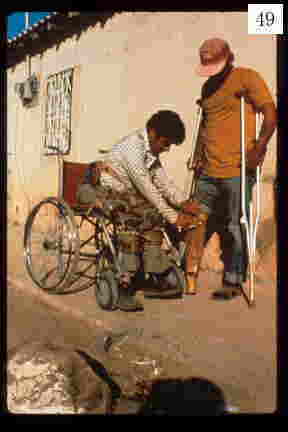
|
(Slide 49) Here is a boy in a wheelchair making bamboo prosthesis for a young amputee. To make the prosthesis, they split the bamboo into rags and put it over a plaster mould of the leg stump. Then they cover the bamboo with a mixture of sawdust and glue, which hardens into a wood-like prosthesis. This is a technology that comes from Handicap International in Thailand. We were able to send one of our village workers to Thailand to study how to do this. This kind of interchange between programs and sharing of experiences is important. Here is a man who has one of these bamboo limbs and is walking on it. But many people in Mexico say this bamboo technology is too primitive. They want something that looks nice and more normal. So the team has learned how to make limbs with resin and fiberglass. |
|
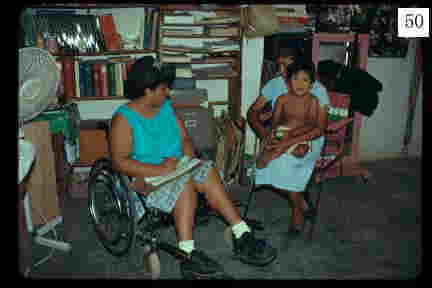
|
(Slide 50) Here you see Mari, a disabled leader of the program, evaluating the needs of this little boy. When he was a baby, he lived in a city slum near the railway tracks and had both of his legs cut off by a train. |
|

|
(Slide51) Wheelchairs - another big problem in poor countries! So the team has learned welding skills and how to make a sort of Jeep or Land Rover wheelchairs for rough terrain. |
|
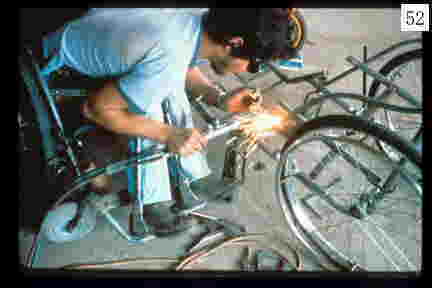
|
(Slide52) Here is one of the master wheelchair builders. Because he is also a wheelchair rider, he has a better understanding of the needs of other people who ride wheelchairs. |
|
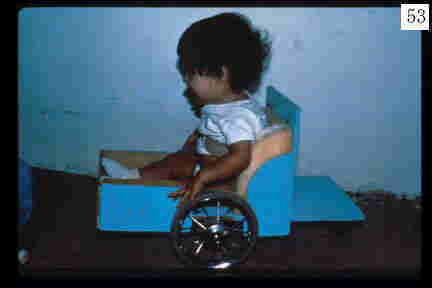
|
(Slide 53) Some of the wheelchairs can be very simple as for this child with spina bifida. This small wooden wheelchair gives the child a chance to begin to move about and to explore the world at the same age that other children do. One of the best things that happened in PROJIMO for gaining respect of the community happened completely by accident. The disabled workers learned to weld metal in order to make wheelchairs. Because they were the only people who had that skill in the village, the farmers came with their plows and the children with their bicycles to have them welded when they broke. In this way, the community gained a big respect for the so-called disabled people, not because of their disabilities but because of their abilities. |
|
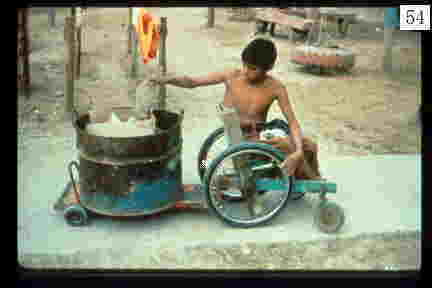
|
(Slide 54) A simple wooden wheelchair has much lower cost. In this case, the boy has a cart attached to it to do the garbage cleanup. |
|
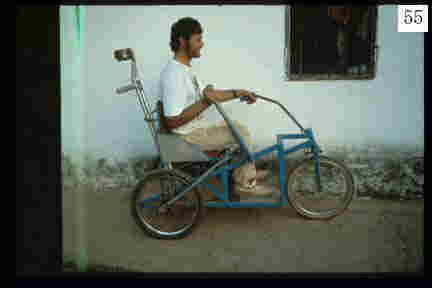
|
(Slide55) This is one of the tricycle models that they are now making in Mexico. You can see lots of these in Asia and Africa but not in Latin America. It is a real new feature for Latin America. |
|
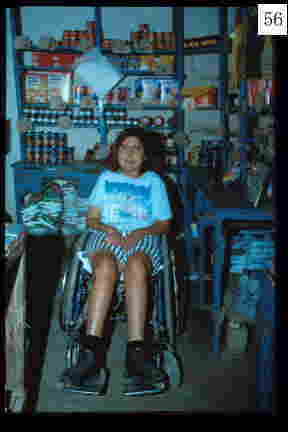
|
(Slide 56) Margarita is severely disabled. She has almost no use of her hands but the village chose her to run the government-subsidized store. Because Margarita is the first person who has been honest to run the store, the store has come out ahead rather than at a loss. The community has a special respect for this disabled person who is doing a better job than non-disabled persons had done. When she first came to PROJIMO, Vanya was malnourished, covered with head lice and had severe pressure sores. But in PROJIMO, she found a family that was supportive and appreciative of her, and she blossomed. Here she is working with other children in the toyshop. The rehabilitation workers discovered that Vanya loved to help other children. They gave her bigger and bigger responsibilities. |
|
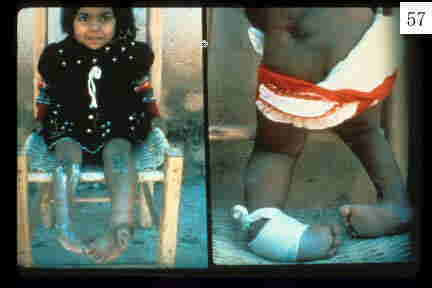
|
(Slide 57) This is one of the children that Vanya helped. Jessica. When she was 3 days old, Jessica was injected in the backside with a dirty needle. The injection caused a big infection, an abscess that spread to her spine and caused paraplegia. She could pull herself to standing but with her feet bent over like this. So she developed a big sore on the top of her foot. Her feet were contracted in a way that would make walking impossible even with braces. So the village team casted her feet to slowly straighten them. They left a window over the sore so it could be treated. Here Vanya is treating Jessica's pressure sore. |
|
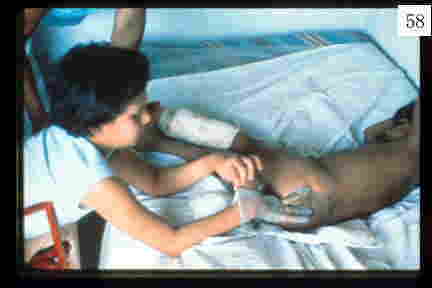
|
(Slide 58) Here Vanya is doing the bowel program of the younger girl. Stimulating the rectum with a finger causes the child to have a bowel movement at that moment, so that the child does not have an accident during the day. Essentially Vanya at the age of ten is providing very expert nursing services to another child. You can imagine the self-confidence and pride created in this little girl whose earlier life had been absolute misery. This was very, very important for both of the girls. |
|
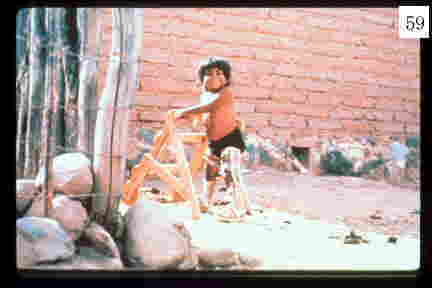
|
(Slide 59) Mexico, in the last few years, has gone through an economic crisis, for reasons very similar to the economic crisis that is affecting Asian countries today. It is a crisis that comes from the unregulated market system that makes the rich richer and the poor poorer. As part of this crisis, we have seen a fall in unemployment, a fall in wages and an increase in drug use, drug trafficking, crime and violence. In the last five years, PROJIMO has attended to the needs of over 400 spinal cord injured persons. Bullet wounds cause the vast majority of those injuries. In Sinaloa State of Mexico where PROJIMO is found, the fifth most frequent cause of death is homicide. There is an enormous incidence of disability caused by violence. |
|
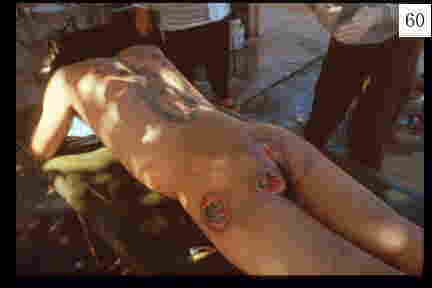
|
(Slide 60) This is a young man who was a drug trafficker, lived on the streets, the tattoo is sort of a symbol of that sub-culture of drugs and violence. He was shot through the spine. When he arrived at the program, he had severe pressure sores with dead black flesh in them down to the bone. In the Third World, most spinal cord injured persons don't live more than one or two years and they die mostly from pressure sores. In a poor country or community, you cannot get involved with disability without becoming involved with human rights. |
|
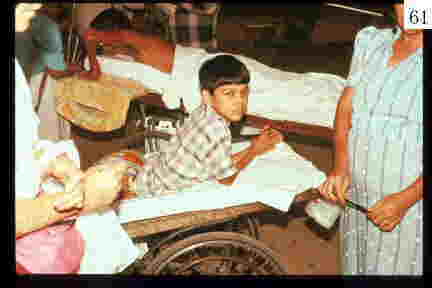
|
(Slide 61) This little boy, when he was 12 years old, made the mistake of asking a policeman, "What caliber is your pistol?" The policeman said, "This", pulled out his gun and shot the boy through the spine. So the village program has been fighting with the city authorities to make them provide the resources needed so the boy can stay alive, stay in school, and make something of his life even if he is disabled. The use of honey in the treatment of pressure sores has been found to be one of the most effective treatments. If people are interested in that, I will explain later how it works. |
|
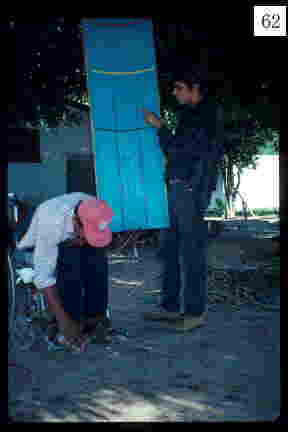
|
(Slide62) This is equipment that was designed in PROJIMO to test how much pressure is on the backside to avoid pressure sores. The person can use it to know the importance of changing positions and how that lowers pressures over the bony areas to prevent sores. |
|
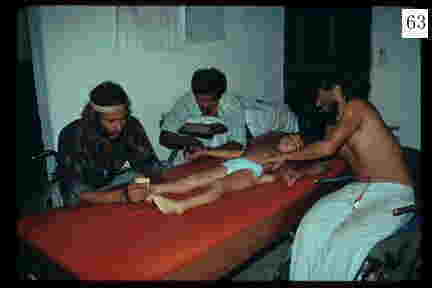
|
(Slide 63) One of the wonderful things that has happened in PROJIMO is to see the transformation that takes place in some of these young people coming out of this sub-culture of drugs, violence and crime. Some of them have become the most loving, caring rehabilitation workers you can imagine. Like the three men here who are providing exercises to a child with muscular dystrophy. One of the wonderful things that has happened in PROJIMO is to see the transformation that takes place in some of these young people coming out of this sub-culture of drugs, violence and crime. Some of them have become the most loving, caring rehabilitation workers you can imagine. Like the three men here who are providing exercises to a child with muscular dystrophy. |
|
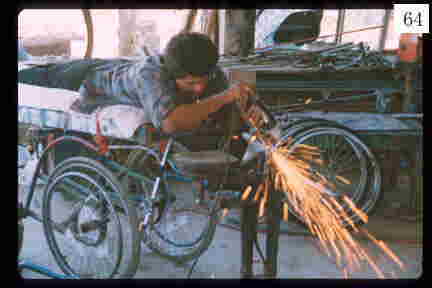
|
(Slide 64) This is another one of the young men, who came out of the subculture of violence, who has become a master wheelchair builder. |
|
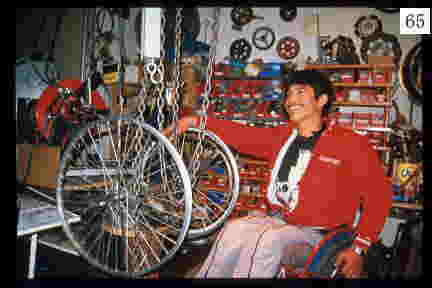
|
(Slide 65) Another one of the spinal cord injured persons is making wheelchairs. |
|
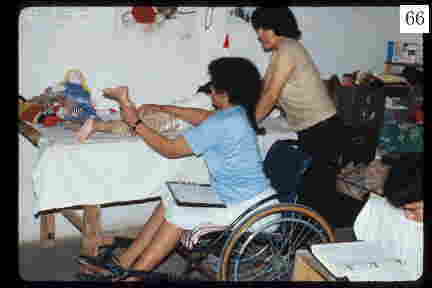
|
(Slide 66) Here is Mari and the mother of a child with cerebral palsy. This mother came from a thousand miles away because the doctors told her that her child was a vegetable and that there was no hope for her. So the mother and child stayed for two years at PROJIMO. The mother became a very good rehabilitation worker and the child advanced enormously. Since then, this mother married another worker in PROJIMO, went to another state in Mexico, and started a new community-based program. In this way, the program has been multiplying around Mexico. |
|
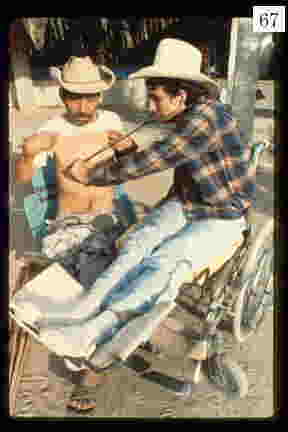
|
|
